For Akiva Schaffer’s buddy alien comedy The Watch, not only did Digital Domain have to create CG out-of-this-world creatures, they also had to blow up a cow, and a Costco. We talk to visual effects supervisor Kelly Port about the film.
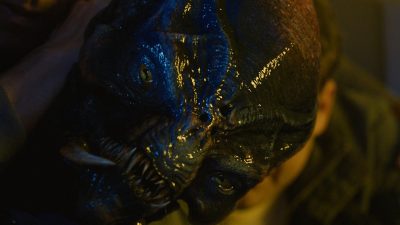 fxg: How did Digital Domain craft the CG aliens?
fxg: How did Digital Domain craft the CG aliens?
Port: Well, Legacy Effects, the practical creature company, designed the built suits for performance actors to get into. We had always planned to do some CG aliens, but the original plan for the close-up hero work where you just see an arm or a face was to use these suits. What ended up happening was that we used some of the suits, but as some of the dynamics of a particular scene unfolded, and the director wanted to give a sense that these things were not human, and literally not look like guys in a suit, so we did a lot of them in CG.
The guys in the suit had limited mobility, so as the creatures scampered around and did big jumps and climbing around walls, it became easier to do a CG version of that. We ended up doing up to 300 closer to 400 alien animations. Some of them were big shots where you’d have 40 to 60 aliens in a single shot. Most of the time it was just a few, anywhere from just a single one to 5 or 6 in shot. It varied considerably.
fxg: What animation techniques did you use?
Port: We used a combination of both. We did a day’s motion capture session at our studios at Playa Vista. We went through a series of motions with our performers. It was challenging because there wasn’t anything we could use a hundred per cent – mostly because in the really active scenes where they are running and jumping, not only are the proportions slightly different, which you can scale in a rig, the director really didn’t want it to appear as any recognizable animal, especially a human. It couldn’t walk like an ape, or crawl like a chimp.
Working with Steve Nichols, our animation supervisor, we found the best approach was, as the alien was in a run, say, it would never really be in a particular cycle for very long – it would always move from one to the other – it would jump or grab onto the side. The viewer never really has time to settle on a particular characteristic to allow them to say, ‘Oh, that’s a cheetah or an ape…’.
– Above: watch a breakdown of Digital Domain’s VFX for The Watch, thanks to our media partners at The Daily.
fxg: What approach did you take to the texture of the aliens?
Port: We took Legacy’s original Zbrush model which was a super hi-dense mesh and rebuilt from scratch using it as a guide but then as something that could be UVd and more of a production model. In terms of its texture and skin it was very much a moist dark, kind of like the alien in the Alien movies. It was that dark slimy-like surface – that was something we had quite a bit of challenge dialling in in each shot – the specular quality of the highlights. It was like plastic, but that has a particular nature to its specular highlight versus something that’s wet or slimy – which has a thin coating – relatively clear coating on top.
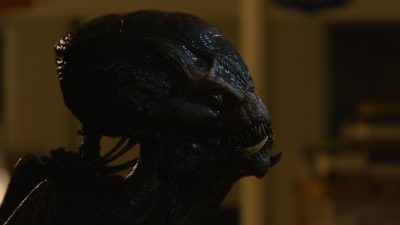 The note about slimy kept coming up so often that Jordi Cardus our look dev supervisor actually had to implement an additional layer of additional noise that compositors could use. That allowed us to not necessarily have to re-render if we didn’t have to. But let’s say we wanted to have some additional specular break-up, we could use that noise map to break it up on top of the existing lighting render. The bump and displacement could be used just to find the right balance. We were using Katana for lighting and Arnold for rendering.
The note about slimy kept coming up so often that Jordi Cardus our look dev supervisor actually had to implement an additional layer of additional noise that compositors could use. That allowed us to not necessarily have to re-render if we didn’t have to. But let’s say we wanted to have some additional specular break-up, we could use that noise map to break it up on top of the existing lighting render. The bump and displacement could be used just to find the right balance. We were using Katana for lighting and Arnold for rendering.
fxg: Can you break down a particular sequence with the alien?
Port: Bob (Vince Vaughn) has this man cave where the Watch team meet – this is when they’ve just discovered this alien and unveil it. They think they’ve killed it by knocking it over the head with a garden gnome. But to their dismay it awakes and freaks them out. It starts jumping around the walls. Ben Stiller’s character jumps on its back and then it runs along the walls with Ben holding on. Then they all pounce on it, but it breaks free and jumps out the window.
In terms of shooting, on set we would always have the Legacy hero performer. They would get that performance in-camera. Then we would shoot a clean plate in case they were changing it out later to put a CG alien in. The practical suit served as fantastic lighting reference for us, and then for each one of those lighting setups we’d grab a HDRI, and get the correct camera information – lenses and positions, dollies or moves. And we’d repeat the same setup for every shot in the scene. We had some of the stunt performers running along the walls on wires, which was really great as lighting reference too.
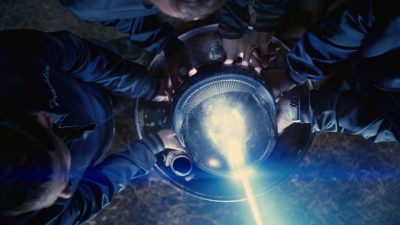 fxg: At one point the watchers blow up a series of things with an alien weapon ball – how did you achieve those shots?
fxg: At one point the watchers blow up a series of things with an alien weapon ball – how did you achieve those shots?
Port: They don’t know what it does and they’re playing with it and sticking their fingers around it and then blow up a cow. And they’re like, ‘Oh my God that’s so cool!’, and then the blow up everything else. It’s what anybody in that situation would do right, if you found an alien weapon ball – wouldn’t you just blow everything up? We took care of the beam itself and all the energy effects. Most of the explosion themselves were practical, which was fun – I almost lost my hearing on one of them – I was too busy taking pictures to cover my ears. They blew up the shell of a cow – the shape, but we had to match that shape with a CG cow. They packed that cow filled with blood and blood soaked rags – it was awesome!
fxg: What was built practically for that weapon?
Port: They built a practical version that had a bunch of holes in it that you could stick your fingers in, and there was a pneumatic device that spread the ball open along a seam, revealing a few more holes. It had a lot of cool LEDs inside – and was a really nice prop. It had a bunch of wires coming out the back, so we had to remove those whenever they were holding it. For the beam itself, they wanted the ball to become semi-translucent, so we had to replace it whenever it was very active in order to see this intense plasma effect right before it shoots.
When it shoots, it’s got a nice high-energy beam to it, all done in Houdini and augmented heavily with Nuke using glows and lens flares. For the cow itself, we would run sims with additional debris. One of the things with the cow specifically was that it was a plexi-glass shell, so when it exploded, even though it had a lot of cool organic material on the inside, we actually had to remove a considerable amount of the plastic shell because that just didn’t look like a real cow. I mean, every time I’ve exploded a real cow, I’ve never seen that…
At the beginning of it, to tie in the energy beam, we augmented the fire ball to be a little bit more blue evolving to more natural oranges and reds, and then added more arcing and sparks. As the front of the beam hits, there’s a scanning effect – scan lines going over the target which happens very briefly – the logic being the weapon is intelligent and analyzes its target’s shape before it blows it up. We did all of that with the things they exploded – a tractor, a shed and some bales of hay – and at the end with Costco itself.
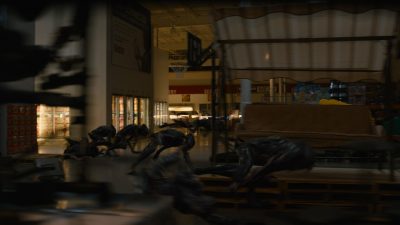 fxg: The aliens have established a hive at Costco which as you say they ended up blowing up – how did you animate multiple aliens for those scenes?
fxg: The aliens have established a hive at Costco which as you say they ended up blowing up – how did you animate multiple aliens for those scenes?
Port: Well, the reason they’re at CostCo is that they can get everything under one roof, of course. They can get a transmitter signal to get an armada to destroy earth. There’s one scene that had quite a number of aliens where they come to door, and they were hand-animated. For one shot where we look into the hive and see probably 100 aliens coming towards us, we ended up using a particle-driven technique. We found some run cycles all going at the same speed and had the aliens parented to those points. We made sure they were far away enough from each other to make sure they didn’t intersect. For most of the multiple-aliens shots in Costco, they were keyframed or relied on augmented mocap.
fxg: How did you blow up Costco?
Port: So we had a big pyrotechnic sequence at the very end where the hero guys blow up the CostCo. We shot at a made-up CostCo on set, fully designed to look like a CostCo both inside and outside, but when it came to blowing it up, we took over at that point and destroyed the whole building which was really fun.
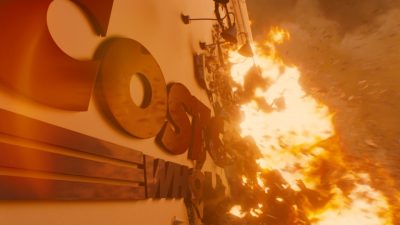
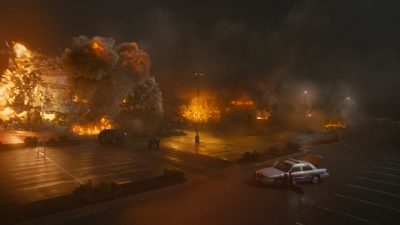
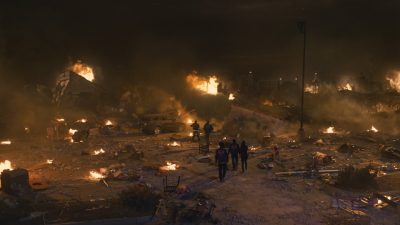
While we we there, we surveyed and measured what we needed to do to build the exterior of Costco. We also built some of the interior as well. We cut it up for a rigid body dynamic sim – one part of our effects team would be dealing with the sim for the RBD and we used that as the main driver of the timing. It didn’t just blow up in one big explosion – it was a series of explosions. This was over a period of time and over a few different shots.
The basis for that was always Houdini, but our version is what we call Drop – a slight modification of what we had developed for 2012, which uses the Bullet physics engine.
We then moved onto the pyro simulation, based on the RBD sims. The digital pyro was rendered with Mantra. The RBD was providing the rough timing and debris. Then once we got the pyro working – we were always making sure the scale was working and wasn’t too over the top – then we had to go back and add a lot more additional debris.
fxg: Did you have any particular compositing challenges?
Port: In Nuke, we had nice matte paintings that were projections – the remnants of the explosion were done as set extensions. Where we were looking we really wanted to look deep into the background and we had to create these windows into the other side of a crater so we could see across the way. We also used Nuke in a cool way to rely on the p pass layer to track in practical squib hits for when the aliens were getting shot – we could track in destructive tissue damage and splatter wherever we wanted to.
All images copyright 2012, 20th Century Fox.
